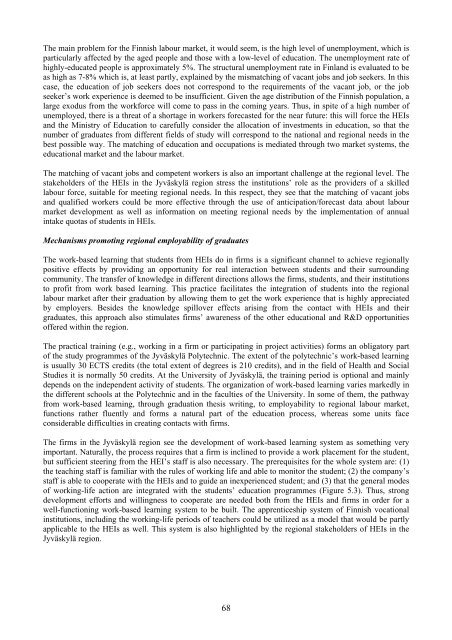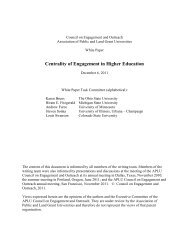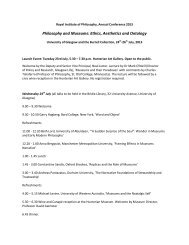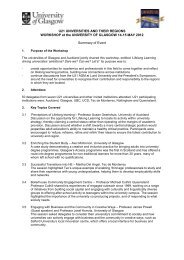in terms of jointly organized special courses and/or education programmes, might support the more effectiveuse of both financial and personnel resources, and enable institutions to extend their regional networks.Placing graduates in the regional labour marketThe Career service unit at the University of Jyväskylä annually monitors the flow of Master’s degreegraduates into working life, covering each faculty separately. This process is carried out through the postingof a questionnaire for graduates during the observation period. The questionnaire maps information, such asabout the person’s current status in the labour market, and his/her province of residence at the time of theresponse. Due to the time lags, the working time of graduates varies from one to two years. The reliability ofthese results is rather weak due to the low response rate, which, in 2004, was 55%. However, according tothe results, approximately 80% of students were employed 1-2 years after their graduation and 35% of allrespondents were still living in Central <strong>Finland</strong>. The rate of graduates staying in the region varies betweenthe faculties. According to the most recent survey, more than half of the graduates from the Faculties ofInformation Technology and Mathematics and Science were living in Central <strong>Finland</strong> 1-2 years after theirgraduation, whereas only one fourth of graduates from the Faculty of Sport and Health Sciences remained inthe region after their graduation.The Jyväskylä Polytechnic also systematically gathers information about their graduates. The statistics fromthe latest survey cover more than 90% of the graduates. In 2004, 61% of graduates were employed at themoment of their graduation, of which two thirds worked in Central <strong>Finland</strong>. The share of students graduatingfrom the fields of Information Technology, Business, and Health and Social Studies was the highest(exceeding 70%) among those who had been employed within Central <strong>Finland</strong>. Due to the different periodsof observation and the differences in response rates, the results from the Polytechnic and University surveysare not comparable.In addition to the HEIs’ own surveys, other studies have also focused on this area. A recent study made bythe Employment and Economic Development Centre of Central <strong>Finland</strong> (2005) has gathered information onthe students graduating from Central <strong>Finland</strong>’s educational institutions in 2000-2003, their labour marketstatus, and province of residence at the end of the year 2003. The data is based on the database of Statistics<strong>Finland</strong>. The findings indicate that the employment rate of the graduates from the Jyväskylä Polytechnic was80%, with the unemployment rate being 8%. Among the university graduates, the figures were 81% and 7%,respectively. The results support the regional role of the Jyväskylä Polytechnic as a provider of a skilledlabour force when compared to the University of Jyväskylä: 61% of the polytechnic’s graduates appear to bestaying in Central <strong>Finland</strong>, whereas only 36% of those graduating from the university are currently living inthe region.In a working paper from the Pellervo Economic Research Institute (2004), the mobility of newly graduatedhigher education students in 1998-2002 was analysed at a sub-regional level. The main aim of the study wasto discover the amount of newly graduated students staying in the sub-region of their city of study after thepoint of graduation. On average, in the Jyväskylä region, the ”regional retention-rate” of higher educationstudents is about 45% after graduation, with this percentage gradually decreasing to 35-40% in the followingyears.5.3 Graduate employabilityThe building of the polytechnic system and the increasing number of university students has considerablypromoted the expansion of higher education, which has already been very rapid in <strong>Finland</strong> during the last tenyears. With the structural change of the labour force coming into the labour market, the demands for a labourforce have been transformed as well. The increasing use of new technologies and the internationalization offirms have raised the level of required job qualifications. At the same time, however, the lack of blue-collarworkers in traditional fields (carpenters, welders, and so forth) also occurs. Most educational reforms haveclear connections to the changing needs of the labour market, yet the expansion is also due to ”educationalself-propulsion”, which means that the educational level of the population is raised irrespective of thechanges in the occupational structures and demands for skills.67
The main problem for the Finnish labour market, it would seem, is the high level of unemployment, which isparticularly affected by the aged people and those with a low-level of education. The unemployment rate ofhighly-educated people is approximately 5%. The structural unemployment rate in <strong>Finland</strong> is evaluated to beas high as 7-8% which is, at least partly, explained by the mismatching of vacant jobs and job seekers. In thiscase, the education of job seekers does not correspond to the requirements of the vacant job, or the jobseeker’s work experience is deemed to be insufficient. Given the age distribution of the Finnish population, alarge exodus from the workforce will come to pass in the coming years. Thus, in spite of a high number ofunemployed, there is a threat of a shortage in workers forecasted for the near future: this will force the HEIsand the Ministry of Education to carefully consider the allocation of investments in education, so that thenumber of graduates from different fields of study will correspond to the national and regional needs in thebest possible way. The matching of education and occupations is mediated through two market systems, theeducational market and the labour market.The matching of vacant jobs and competent workers is also an important challenge at the regional level. Thestakeholders of the HEIs in the Jyväskylä region stress the institutions’ role as the providers of a skilledlabour force, suitable for meeting regional needs. In this respect, they see that the matching of vacant jobsand qualified workers could be more effective through the use of anticipation/forecast data about labourmarket development as well as information on meeting regional needs by the implementation of annualintake quotas of students in HEIs.Mechanisms promoting regional employability of graduatesThe work-based learning that students from HEIs do in firms is a significant channel to achieve regionallypositive effects by providing an opportunity for real interaction between students and their surroundingcommunity. The transfer of knowledge in different directions allows the firms, students, and their institutionsto profit from work based learning. This practice facilitates the integration of students into the regionallabour market after their graduation by allowing them to get the work experience that is highly appreciatedby employers. Besides the knowledge spillover effects arising from the contact with HEIs and theirgraduates, this approach also stimulates firms’ awareness of the other educational and R&D opportunitiesoffered within the region.The practical training (e.g., working in a firm or participating in project activities) forms an obligatory partof the study programmes of the Jyväskylä Polytechnic. The extent of the polytechnic’s work-based learningis usually 30 ECTS credits (the total extent of degrees is 210 credits), and in the field of Health and SocialStudies it is normally 50 credits. At the University of Jyväskylä, the training period is optional and mainlydepends on the independent activity of students. The organization of work-based learning varies markedly inthe different schools at the Polytechnic and in the faculties of the University. In some of them, the pathwayfrom work-based learning, through graduation thesis writing, to employability to regional labour market,functions rather fluently and forms a natural part of the education process, whereas some units faceconsiderable difficulties in creating contacts with firms.The firms in the Jyväskylä region see the development of work-based learning system as something veryimportant. Naturally, the process requires that a firm is inclined to provide a work placement for the student,but sufficient steering from the HEI’s staff is also necessary. The prerequisites for the whole system are: (1)the teaching staff is familiar with the rules of working life and able to monitor the student; (2) the company’sstaff is able to cooperate with the HEIs and to guide an inexperienced student; and (3) that the general modesof working-life action are integrated with the students’ education programmes (Figure 5.3). Thus, strongdevelopment efforts and willingness to cooperate are needed both from the HEIs and firms in order for awell-functioning work-based learning system to be built. The apprenticeship system of Finnish vocationalinstitutions, including the working-life periods of teachers could be utilized as a model that would be partlyapplicable to the HEIs as well. This system is also highlighted by the regional stakeholders of HEIs in theJyväskylä region.68
- Page 1 and 2:
OECD/IMHE ‐ Supporting thecontrib
- Page 3 and 4:
SUMMARYTogether with 13 other regio
- Page 5 and 6:
8.2 Increasing the regional effecti
- Page 7 and 8:
I INTRODUCTION1.1 Strengthening the
- Page 9 and 10:
development. The aim is that region
- Page 11 and 12:
The self-evaluation considered here
- Page 13 and 14:
densely populated cities in Finland
- Page 15 and 16:
1,9 %1,7 %1,5 %1,3 %Population chan
- Page 17 and 18: The share of jobs in primary produc
- Page 19 and 20: New pillars of future’s developme
- Page 21 and 22: Jyväskylä0,60,91,11,0Central Finl
- Page 23 and 24: 2.4 Governance StructureMunicipalit
- Page 25 and 26: of its development outside the cent
- Page 27 and 28: III CHARACTERISTICS OF THE HIGHER E
- Page 29 and 30: continuing education and open unive
- Page 31 and 32: The Science and Technology Policy C
- Page 33 and 34: 3.2 Regional dimension within the n
- Page 35 and 36: order to respond to the challenges
- Page 37 and 38: 14001200Master's degreesDoctoratesN
- Page 39 and 40: 900800Youth graduatedAdult graduate
- Page 41 and 42: provide information for the basis o
- Page 43 and 44: CabinetParliamentSTPCSteering (andf
- Page 45 and 46: 5,04,0Billion euros3,02,01,00,083 8
- Page 47 and 48: The number of refereed articles is
- Page 49 and 50: Centre of expertisePaper industryBi
- Page 51 and 52: The Institute for Environmental Res
- Page 53 and 54: and systematic gradually progressin
- Page 55 and 56: are seen to be very important chann
- Page 57 and 58: Internal support units of HEIsThe F
- Page 59 and 60: of interviewed HEI staffs, the coop
- Page 61 and 62: areas of the region’s Centre of E
- Page 63 and 64: system of Jyväskylä and the HEIs
- Page 65 and 66: V CONTRIBUTION OF TEACHING AND LEAR
- Page 67: esources to establish new activitie
- Page 71 and 72: longer. 2.5% of the Jyväskylä Pol
- Page 73 and 74: activities. As a part of the new qu
- Page 75 and 76: education programmes consisting of
- Page 77 and 78: the TE-Centre of Central Finland an
- Page 79 and 80: practices in the provision of educa
- Page 81 and 82: Reason forskillupgradingDescription
- Page 83 and 84: Strengths+ HEIs are actively confro
- Page 85 and 86: taxation, to lower the unemployment
- Page 87 and 88: Box 6.2 The WIRE -projects: Support
- Page 89 and 90: indoor ice-skating rink, the Rauhal
- Page 91 and 92: The School of Cultural Studies at t
- Page 93 and 94: the number of registered customers
- Page 95 and 96: Box 6.9 Environmental management in
- Page 97 and 98: Strengths+ The significance of HEIs
- Page 99 and 100: eferring to the regional developmen
- Page 101 and 102: Key topics relating to changes in t
- Page 103 and 104: participation in the decision makin
- Page 105 and 106: in the strategy-making process. The
- Page 107 and 108: 7.5 Critical points in promoting th
- Page 109 and 110: 7.Cooperation in strategies concern
- Page 111 and 112: egion is according to national and
- Page 113 and 114: oundaries for further developmental
- Page 115 and 116: joining resources and operations by
- Page 117 and 118: Discussion proposal 15: To ensure d
- Page 119 and 120:
achieved by the horizontal utilizat
- Page 121 and 122:
Appendix 2 Information on data used
- Page 123 and 124:
and finding synergy between the oth
- Page 125 and 126:
School of BusinessRoleThe School of
- Page 127 and 128:
The challenge of the school from re
- Page 129 and 130:
developing wellness and environment
- Page 131 and 132:
Faculty of EducationRoleThe Faculty
- Page 133 and 134:
and/or graduation thesis is a signi
- Page 135 and 136:
Areas of strength and prioritising
- Page 137 and 138:
Agora Center’s partners from the
- Page 139 and 140:
Currently the priority of ITRI’s
- Page 141 and 142:
Weak spots and areas to develop in
- Page 143 and 144:
Employment and Economic Development
- Page 145 and 146:
Appendix 3 Analysis of the most sig
- Page 147 and 148:
Appendix 4 Regional effects (input-
- Page 149 and 150:
The overall value of production cre
- Page 151 and 152:
Appendix 5 Reform of regional struc
- Page 153 and 154:
Appendix 7 Provision of education i
- Page 155 and 156:
Appendix 8 Statistical information
- Page 157 and 158:
Appendix 10 Statistics on financing
- Page 159 and 160:
Appendix 12 Labour market activity
- Page 161 and 162:
Appendix 14 Master’s Programmes a
- Page 163 and 164:
Uusiutuvan energian tutkimusohjelma
- Page 165 and 166:
BIBLIOGRAPHYAcademy of Finland (200










